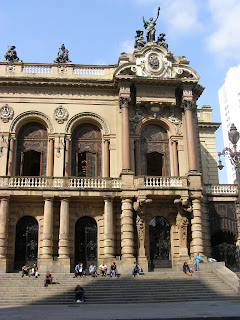Today's guest post features Deniz Bevan, a well-traveled and enthusiastic writer I've come to admire. Here is your introduction to Deniz . . . in Istanbul.
Day One: A Mini-stop in Istanbul!
by Deniz Bevan
I always wonder what I’d do if I took a cruise – they seem to spend only a day or two in each port. How could there be time to see everything?
But then a few years ago, while visiting family in Turkey, I realized our itinerary had only left us two full days in Istanbul! I had to pack in a lot, and now I can share that itinerary with you!
 |
| Turkish Breakfast (Bezan) |
The first thing to do when you wake up is to have a quick breakfast – nothing too heavy, because this is Turkey, and you’ll probably be eating all day, especially if you’re visiting family or friends or even newly-met acquaintances!
There’s probably a bakery near your hotel, no matter what neighbourhood you’re in, so grab some tea and a cheese-filled pastry called
poğaça. Tea comes piping hot in an hourglass, with sugar if you want it, but no milk. You can always add some of the other tasty bits of a traditional Turkish breakfast – sliced tomatoes and cucumbers, olives, and
kaşar cheese – to give yourself energy for the long day ahead.
Start your journey in the neighbourhood of
Eminönü, on the southern side of the Galata Bridge, by taking a streetcar to the courtyard across from Istanbul University.
On your left is the
Beyazid Mosque, built by Sultan Beyazid II in the years 1500-1505; the Sultan himself is buried on the grounds.
Directly before you is the
Sahaflar Çarsısı, the second-hand book bazaar attached to the Grand Bazaar, and one of the oldest markets in Istanbul.
And just a short walk away is the
Mısır Çarsısı, or Egyptian Bazaar, also known as the Spice Bazaar. This bazaar is about two hundred years younger than the oldest parts of the Grand Bazaar.
Back in the 15th Century, Egyptians used to sell their spices here, and the bazaar still features an amazing variety of spices, dried fruits and nuts, teas, sweets, honeycombs and aphrodisiacs from Turkey, Egypt, Iran, and many other countries.
A number of booths offer “Turkish Viagra”, a supposedly potent mix of figs and walnuts, and each booth offers free samples. As you tread the twists and turns of the bazaar, you can almost eat a complete meal!
In the neighbourhood of the bazaars are the
Aya Sofya Museum, the underground Roman cisterns of the
Yerebatan, the
Topkapı Palace, and the
Blue Mosque, among other historical buildings and monuments.
 |
| View of Galata Bridge and Tower (Bezan) |
If you take the necessary hours to visit all of these, it’ll be dinnertime when you’re done!
Hurry across the Galata Bridge and then up through the Galata neighbourhood to the Tower. Originally built in 1348 as the
Christea Turris or Tower of Christ by the Genoese colony in Constantinople, the Galata Tower was later, during the Ottoman period, used as an observation tower for spotting fires.
Up from Galata is
Istiklal Caddesi, a long avenue of many landmarks, including the
Galatasaray High School, Saint Anthony’s Church, and the Pera Museum, just one block away on
Meşrutiyet Caddesi.
 |
"The Tortoise Trainer"
Osman Hamdi Bey
(Wikipedia) |
At the Pera Museum, their permanent, and best, feature is Osman Hamdi Bey’s
Kaplumbağa Terbiyecisi, or "The Tortoise Trainer". This stunning 19th Century work, with its rich reds and intricate details, portrays an Ottoman tortoise tamer; some have suggested that the painting symbolizes the difficulty, or slowness, of achieving social change.
Careful of the tramcar as you head back to
Istiklal Caddesi! If you find your legs beginning to ache from all the walking, you can always hop on the tram as it makes its way up to
Taksim Square.
There are lots of restaurants and cafes to choose from, and the area comes alive at night!
A recently popular area for drinks is
Küçük Beyoğlu Avenue, which was originally a line of old, collapsing Greek buildings but has since been renovated into a quarter of trendy bars and coffee shops. You could even try
kokoreç (seasoned and spiced lamb intestines served with vegetables in a half loaf of bread or pita) – very tasty, I promise!
Deniz Bevan recently returned to writing romance after a foray into Young Adult and Middle Grade novels. She's currently querying my latest romance, Out of the Water, set in Spain and Turkey in 1492 and editing a second romance set in the same time frame, Rome, Rhymes and Risk. She also has a paranormal romance in the works! Deniz writes travel articles and book reviews for the trilingual newspaper Bizim Anadolu and the 100 Romances Blog.
Visit her at http://thegirdleofmelian.blogspot.com/
Plan to return tomorrow for Day Two of Deniz' fabulous tour of Istanbul. Later this week, I'll share a few memories of my own of time spent in Istanbul.
If you have traveled to Turkey, what remains unforgettable?





 Did I see a mermaid on our travels? For your viewing pleasure, a Turkish mermaid. I do not know her story -- yet!
Did I see a mermaid on our travels? For your viewing pleasure, a Turkish mermaid. I do not know her story -- yet!















